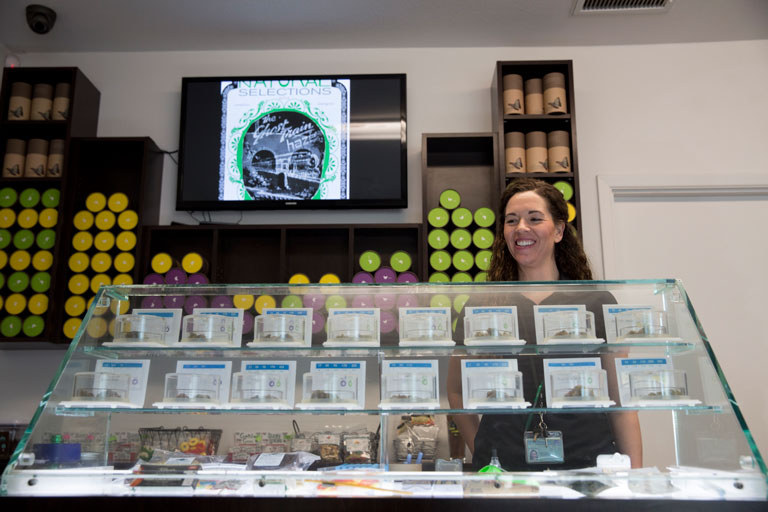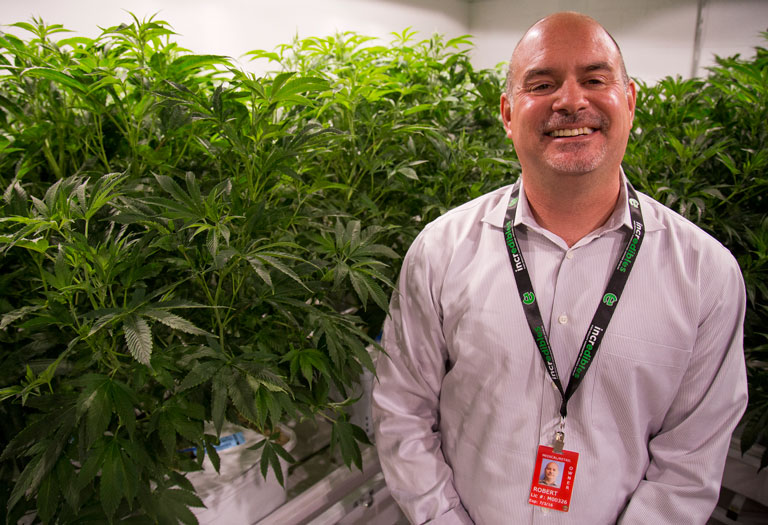A 2014 University of Albany study found that people prefer consuming concentrates for the higher intoxication, which ultimately reduces the number of times they have to consume.
But potency is tricky.
The edibles industry has faced challenges with consistency: THC within a cookie or candy bar isn’t always evenly distributed and labeled correctly. That’s a problem for medical patients who need to take their correct dose, or for recreational users who consume more than the recommended amount for a single serving.
In Colorado, 10 milligrams of THC is the recommended single-serving size for recreational users. But a multi-serving product can contain up to 100 milligrams. For example, “Golden Nugget,” a small bag of candy coated almonds sold at dispensaries like Grass Station in Denver, contains 100 milligrams. This would mean that the recommended serving size would be just one nut.
Colorado and states like Washington and Oregon, which recently set up recreational markets, have had to change laws regarding edibles to include stricter packaging and labeling so consumers can more easily follow the 10-milligram recommendation.
“We’ve added almost a million dollars just to our packaging budget this year,” Eschino said. “This is now the most expensive part of our (candy) bar, the packaging.”
Eschino said all the extra requirements are unnecessary. “You know when you go out and buy a beer, you don’t see where the hops were grown, you don’t see what kind of pesticides they used when they grew the hops,” Eschino said.
However, he applauded the increase in safety awareness, and he said companies have improved consistency over the past year.
Overconsumption can lead to hospitalizations
As the product gets stronger, emergency room visits related to marijuana – from intense hallucinations to hyperventilation and violent illness – have climbed.

Ben Cort, director of professional relations for the Center for Dependency, Addiction and Rehabilitation, said he's concerned for youth's use of marijuana in the state. (Photo by Jessie Wardarski | News21)
“Edibles are what are driving hospital admissions for youth, for animals, for adults,” said Ben Cort, director of professional relations for the Center for Dependency, Addiction and Rehabilitation at University of Colorado Health. “Edibles are this crazy, insane thing that popped up along with concentrates that so many people didn’t see coming.”
Colorado has seen an upward trend of marijuana-related emergency room visits and hospitalizations since the state legalized medical marijuana in 2009, according to the 2015 report by the Rocky Mountain High Intensity Drug Trafficking Area, which coordinates among governmental drug-enforcement agencies.
The report showed that hospitalization visits with possible marijuana exposures grew from 810 in 2006 to more than 2,000 from January to June 2014, many of those directly related to edibles.
"Really, almost exclusively now, the patients we’re seeing for marijuana intoxication in the emergency department are due to edible products,” said Dr. Andrew Monte of the Department of Emergency Medicine and Medical Toxicology at the University of Colorado Denver. “The recreational users that get into edible products or children that inadvertently get into them not knowing what they are.”
The 2015 Rocky Mountain High Intensity Drug Trafficking Area report also states the number of specific THC-infused edible exposures rose from 19 in 2013 to 95 in 2014.
One of the problems with edibles is that because the THC is digested instead of inhaled, it can take up to two hours for the user to start feeling the psychoactive effects. Users can either become impatient or simply not follow the recommended-use guidelines and eat or drink the entire product.
“(It’s) kind of like doing shots of alcohol,” said Christian Thurstone, medical director of Substance Abuse Treatment Education and Prevention Program at Denver Health in Colorado. “You don’t feel it, and then all of a sudden, it hits you and you have an overconsumption of alcohol. So it’s kind of similar.”
Marc Vasquez, chief of police in Erie, Colorado, said it’s also a public-safety concern when people don’t feel the side effects and eat more. “They get in the car, and they start driving and then bang,” he said. “Edibles are a greater hazard for us than smoking marijuana because smoking marijuana gets in your system really quickly, and you know your level of impairment generally. (The risk) is amplified with edibles.”







